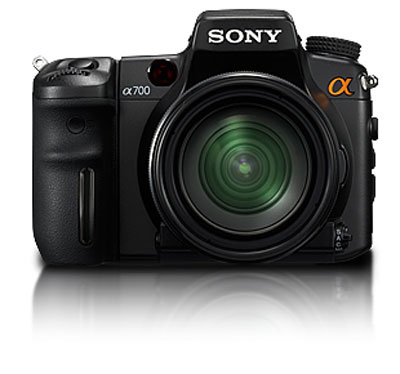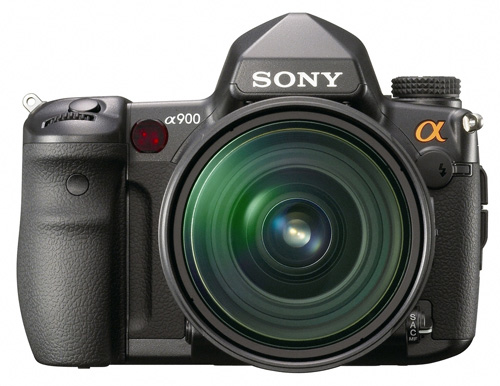Sony A900 Full-Frame: Hands-On Preview
by Wesley Fink on September 12, 2008 12:00 AM EST- Posted in
- Digital Camera
When Sony purchased Konica-Minolta in January of 2006, everyone expected the world's largest digital sensor manufacturer to use the Minolta acquisition to boomerang Sony's entry into the DSLR market. It was soon clear that Sony had ambitious plans for capturing market share in photography's fastest growing market, but the going has been slow.

In the past year Sony has kicked up the pace, beginning with the A700 to compete in prosumer space, followed quickly by the A200 entry-level DSLR, and the A350/A300 DSLRs built with a truly unique and useful Sony implementation of Live View. The Sony Live View is the only Live View that truly behaves like a point and shoot camera in Live View mode. It's as simple as a switch that lets a new user move between Live View and traditional DSLR.
The culmination of the Sony push into the Digital SLR market was unveiled on September 8, after 18 months of hints, speculation, and closed case exhibits at photography events. It is likely that anyone out there who follows photography has at least heard of the A900 - Sony's flagship DSLR and the first to showcase the new Sony 24.6MP full-frame sensor. It also gives the full-frame resolution crown to Sony for the time being, as no other full-frame sensor can claim resolution this high. The closest competitor is the $8000 Canon 1Ds Mark III at 21.1MP.

Sony launched the new A900 in events around the world where invited press and professional photographers were given the opportunity for hands-on time with the A900. It was certainly a controlled environment, with a studio setup with a model and a typical tethered studio shooting product ads. The two environments do reflect how most photographers make their living today, but the manufacturer setups are hardly designed for a competitive comparison. That will have to wait until production cameras arrive in November.
Today we are publishing the A900/Sony DSLR press announcements. You may have already seen the A900 announcement, but we have gathered information on the Sony flagship items together so you can more easily see how the parts contribute to the whole. There was not enough hands-on time to do anything like a thorough analysis of a groundbreaking new camera like the A900. That will have to wait until the release of the A900 in November. However, strong impressions were triggered and we did have enough time with the A900 system to answer many of our questions about the feel, layout, and controls of the new A900. Those impressions are shared on pages seven and eight in our complaints and praise for the new Sony A900.










53 Comments
View All Comments
chiew - Saturday, September 13, 2008 - link
what conditions did the a700 survive in that the 1Ds didn't?hanugro - Friday, September 12, 2008 - link
Hm ,I do remember last year that I heard about shooting video and choosing 1 fram as digital still from SOny CEO himself. I don't know whether it is his idea or he heard from someone else. But Sony has stated that it won't put feature that is not ready. I am sure it has cross Sony's mind. Also they are one that among the first develop sensor that can take 120fps but at lower resolution. You have to understand that this 24MP create about 15MB per frame. If your video is 24fps then does the CF available now is big enough? Also don't tell me that SOny should allow lower HDTV 1920x1080 pixel video and hope that you can extract one frame of it and sell it to newspaper. They will laugh at it, newspaper / magazine needs at least 6-12MP pictures before they consider to publish it. Also if you want video then buy videocam instead. I imagine using liveview (or using the sensor for video) will shorten the live of the sensor itself. Whay would I want to do that?aeternitas - Friday, September 12, 2008 - link
I think people willing to pay 3k for a camera;#1 Dont care about 100$ battery. (wtf?)
#2 Could get something better for a bit more if they want new.
#3 Something better for less if they buy used.
#4 Nikon and Cannon will come out with something better for less in a matter of a few months.
"Full frame" is great, but all it does is get rid of crop factoron 35mm cameras. What happeneds when CCDs get bigger? They will need to, becuse no matter what technology the camera has in it, SnR is going to be better at lower MP resolutions on the same size CCD. 24MP sounds fantastic, but noice reduction does not always equate to added detail. The only real way to get more detail, is to actualy replace noise with information and the real only wat to do that is to make the CCD bigger or make the pixelsites bigger.
gipper51 - Friday, September 12, 2008 - link
Nice preview of a very interesting camera. I did notice several times you mentioned the Sony as being twice the resolution as the D3/5D which is not accurate. It has twice the pixels but you need 4x the pixels to truly double a sensors resolving power.This camera should shake up the industry on the high end. I can't see Canikon shooters ditching their current investments and going with Sony because of this cam, but at the very least the era of high resolution FF cameras costing as much as a new compact car is over. Bravo Sony.
chiew - Friday, September 12, 2008 - link
Just a note: Canon's 1Ds mkIII has a larger viewfinder than the A900 in specs...Canon 1Ds mkIII: .76x 100% FF vf
Sony A900: .74x 100% FF vf
Yea the Canon costs more than 2x as much. However, if history has its say, Canon will trickle down the viewfinder like it did from the Canon 1Ds mkII to the 5D (0.70x in the 1Ds mkII and 0.71x in the 5D). Whatever Canon has up its sleeve, its likely a full frame, and hopefully Canon users will get a nice large viewfinder in whatever the followup to the 5D is.
KorruptioN - Friday, September 12, 2008 - link
As for the bump in fps rate with cropped lenses like Nikon does, apparently this is due to a lens design decision by Minolta. The aperture arm must travel a much more significant distance compared to the aperture arms in Nikon's lenses. This physical requirement alone is likely what is limiting all of Sony's DSLRs to 5fps maximum.Wesley Fink - Friday, September 12, 2008 - link
I shot several images with DT lenses and the A900 crop factor worked perfectly. You can also manually force DT, even on a full-frame lens. With that capability, and an 11 megapixel image size in crop mode, a faster shooting speed would have been an incredible feature. The Nikon 5 megapixel crop-mode image is OK for newspaper but too small for some things. An 11 megapixel crop is a lot more interesting.strikeback03 - Friday, September 12, 2008 - link
The point of an L bracket is to get the flash above the lens regardless of camera orientation. This new flash still has the flash offset to the side, so you still need a bracket if you want to move your flash over top of your lens.Wesley Fink - Friday, September 12, 2008 - link
There are some cases where an in-line flash is more desirable, but for most situations where photographers use a flash the Sony 90 degree turn will accomplish just what the photographer is looking for when he attaches an L bracket.haplo602 - Friday, September 12, 2008 - link
I bought a Nikon F75 as my first SLR after some long search and decision making. Then a few days after it's arrival I learned about the Minolta Dynx 7 and regreted my decision. A few months later I had the opportunity to actualy shoot with a Minolta 7D and I was even more unhappy.Now with this new Sony, I am close to tears. The Nikons I have are solid cameras, I do not complain there, however any Nikon camera close to this Alpha sensor will cost a fortune which I cannot afford. The A900 seems like a quality and "cheap" camera.
(I have to add I never owned a DSLR :-))